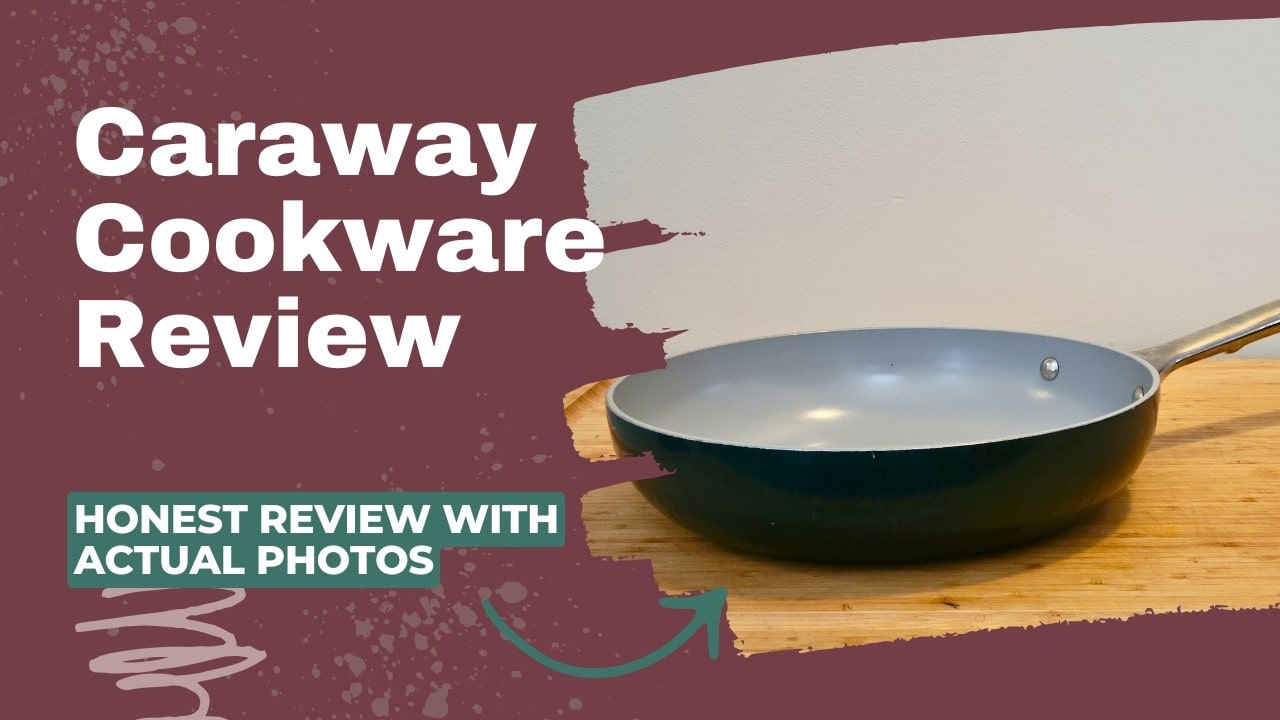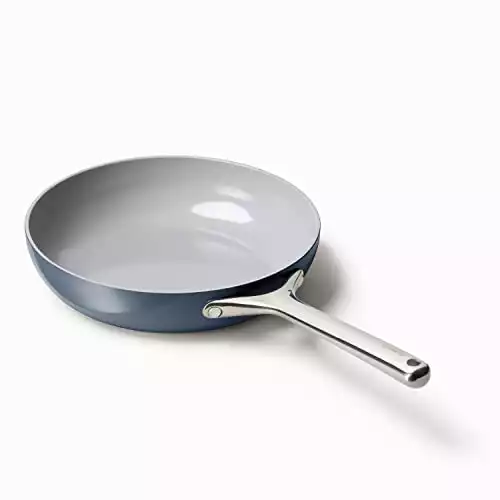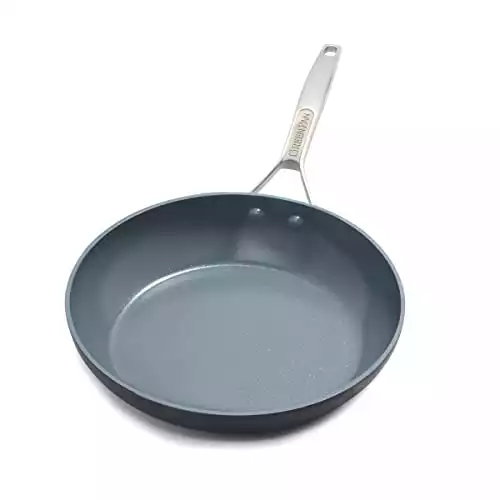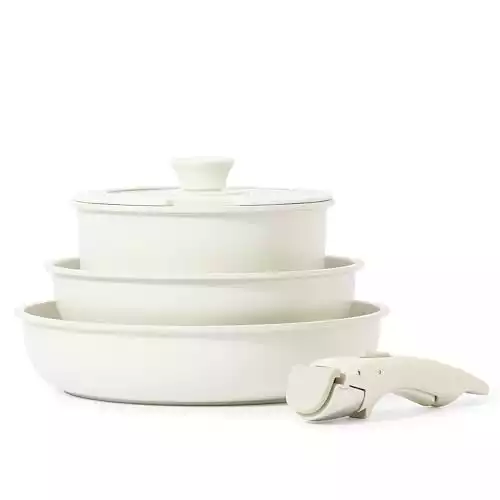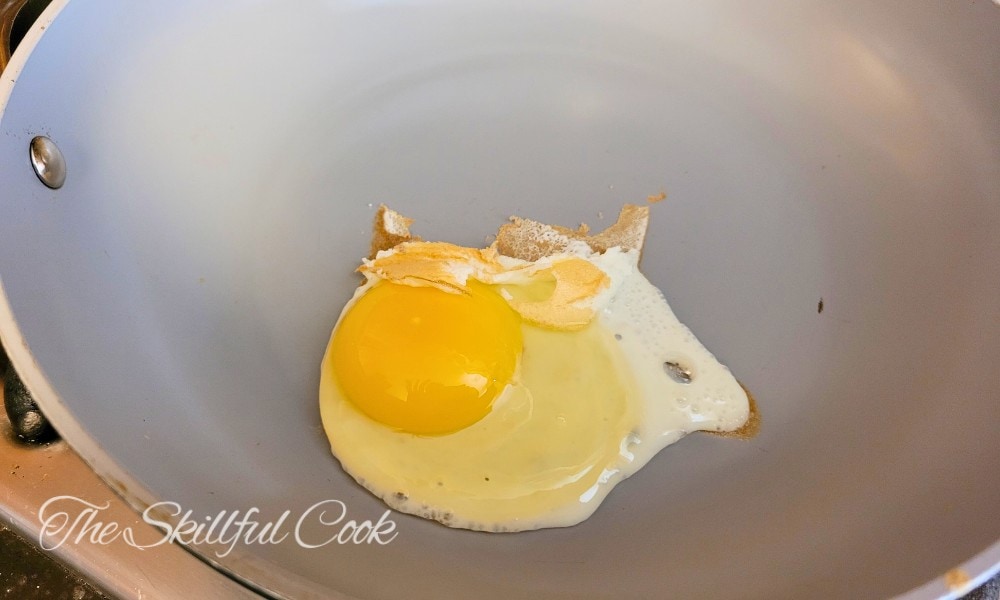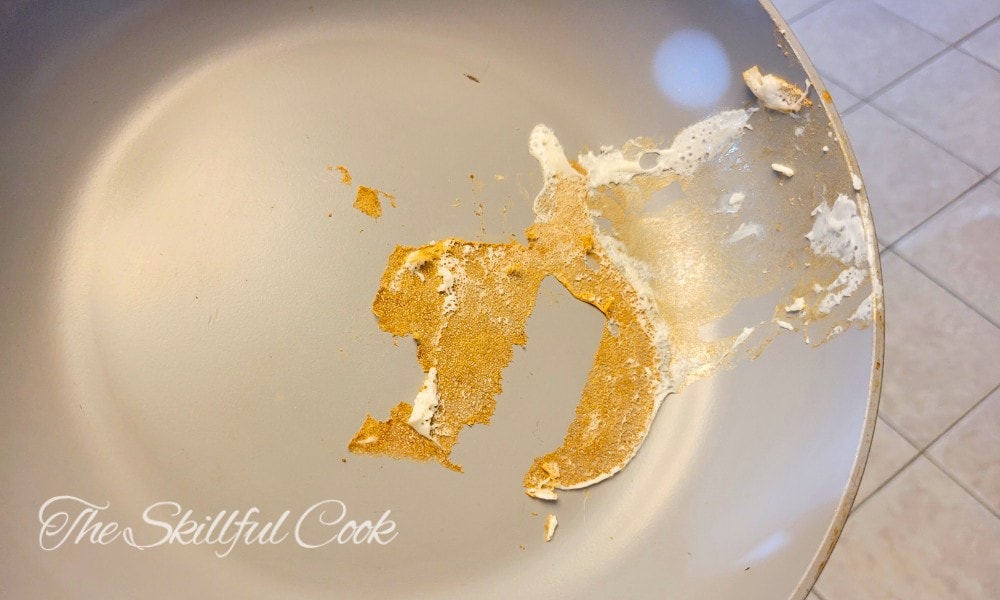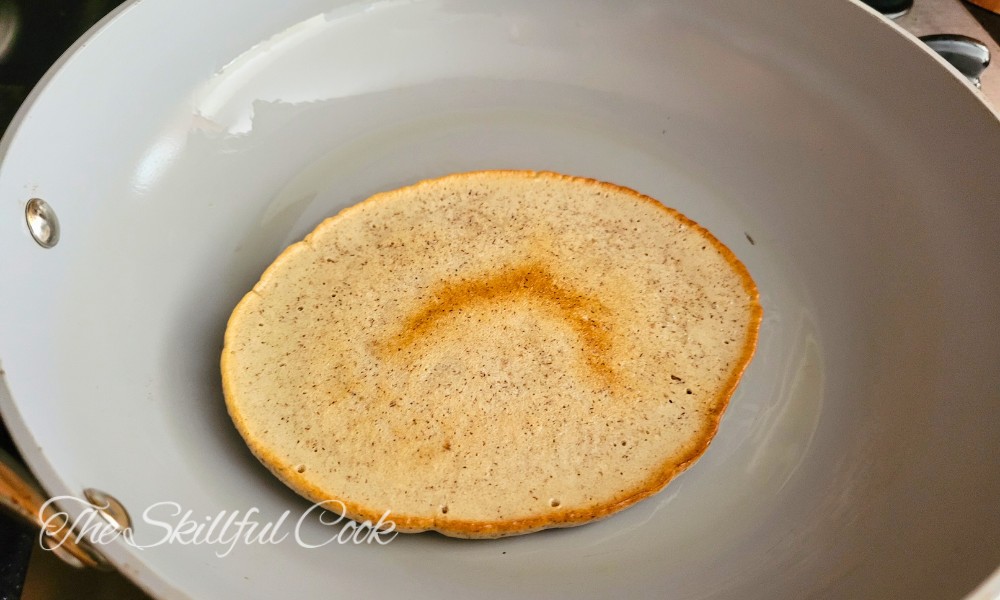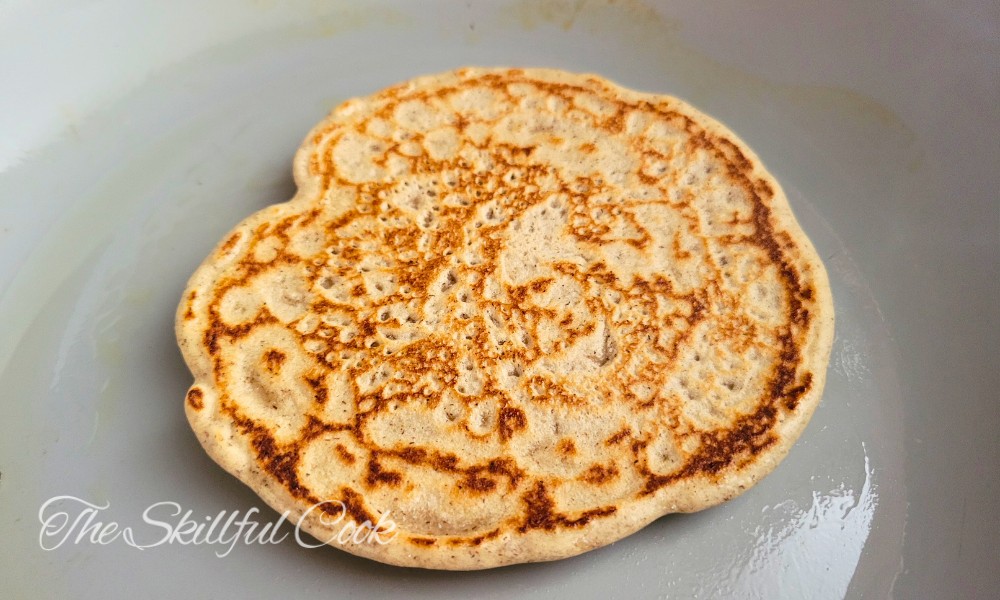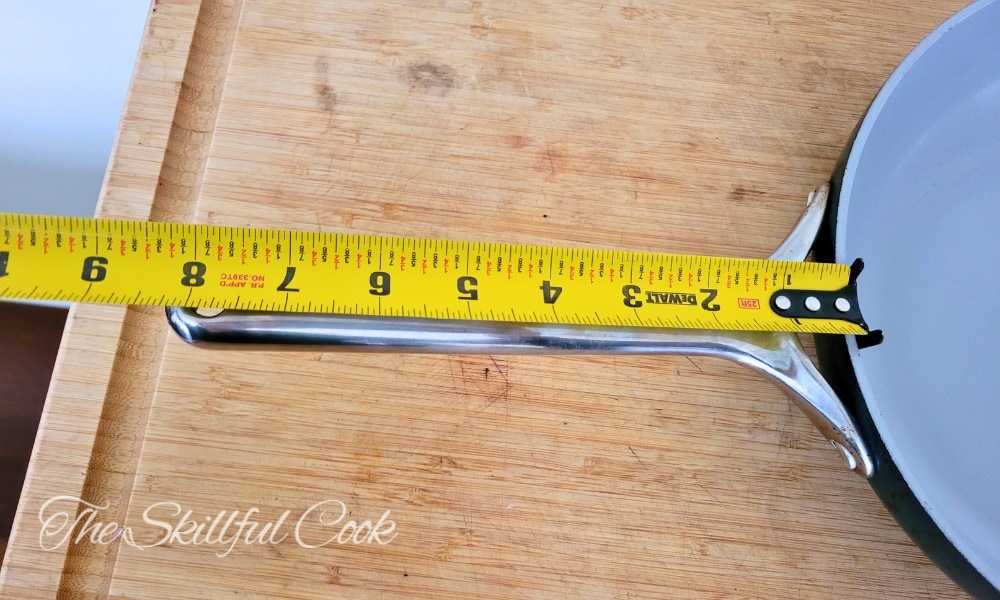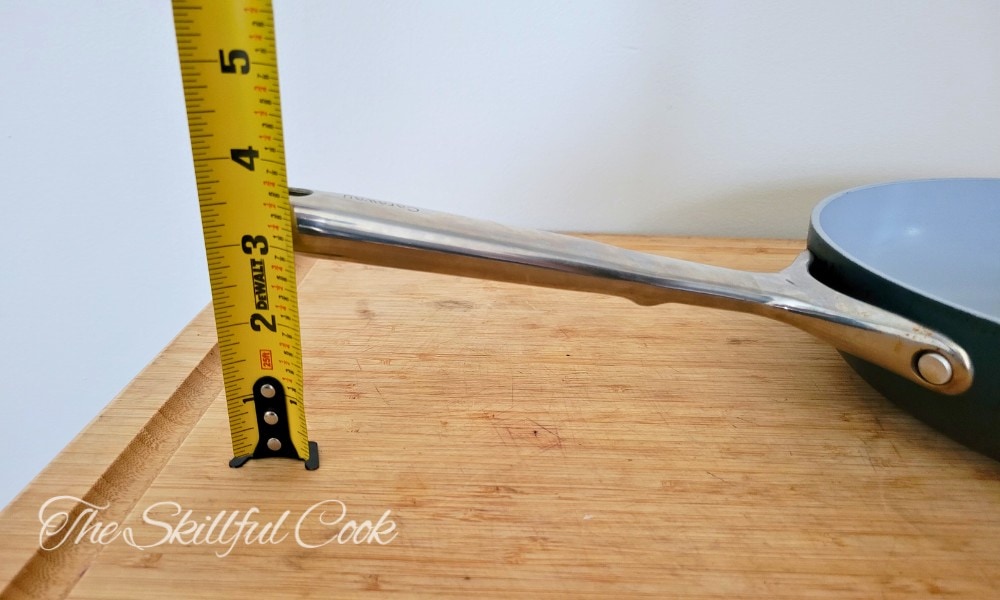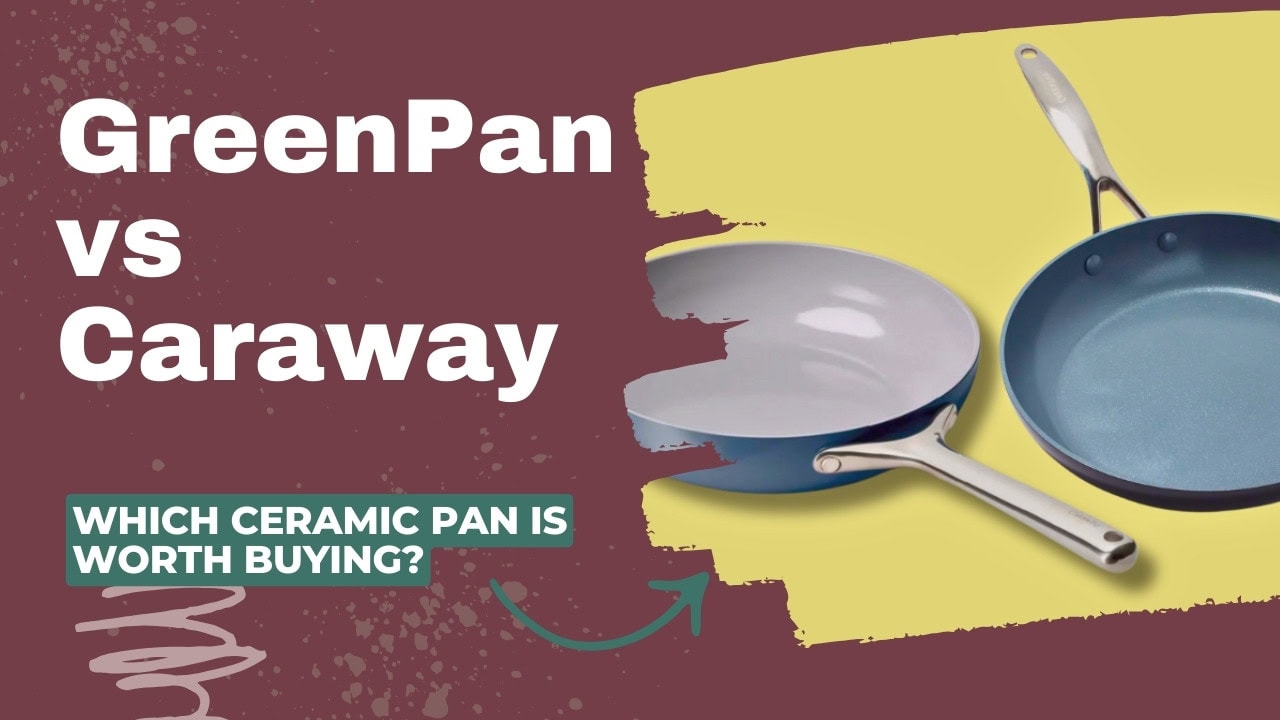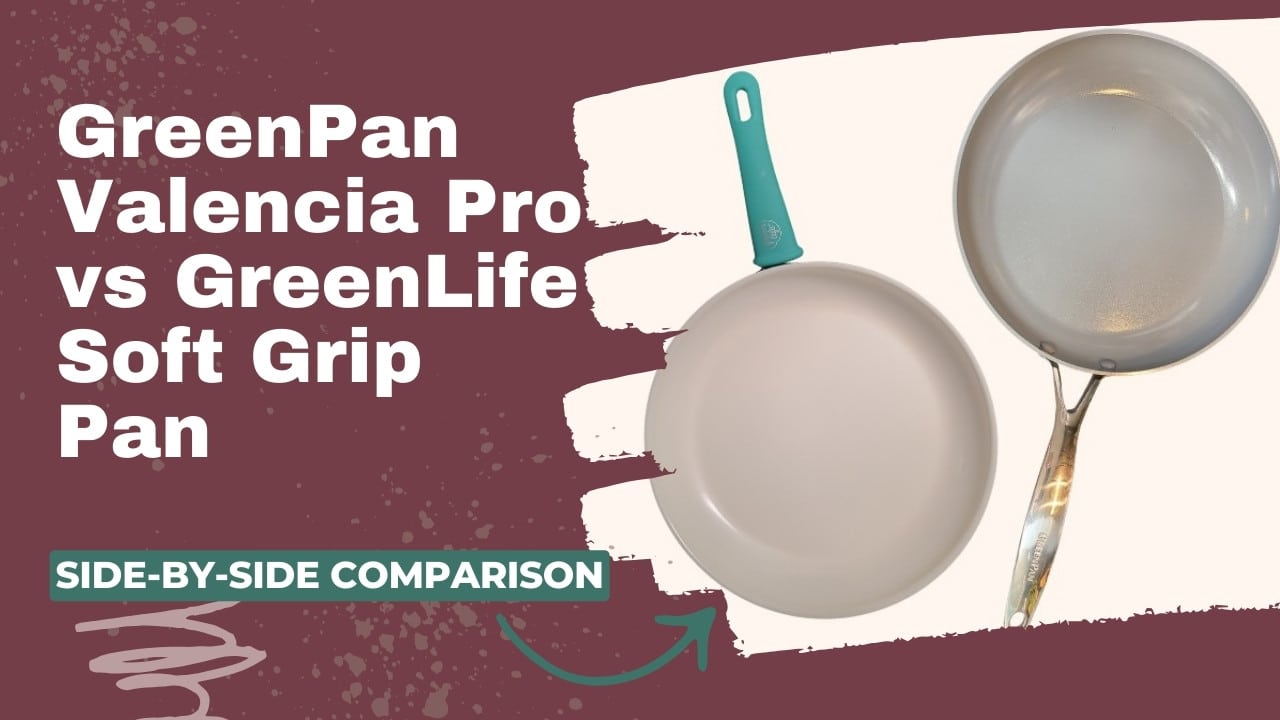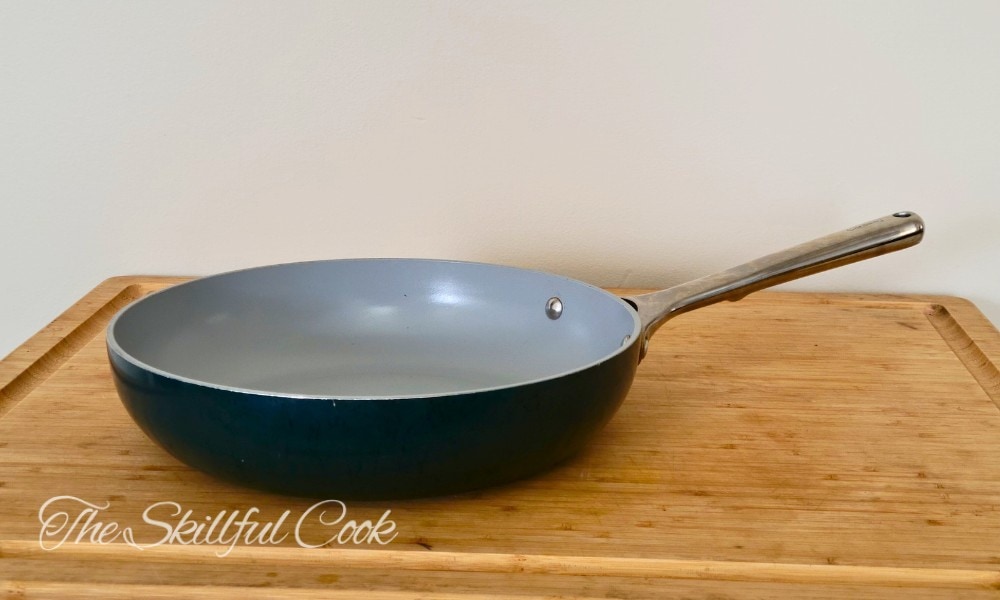
Here at The Skillful Cook, we take our product reviews seriously. We often buy brand-new products and put them through their paces – but we also love to try out previously-loved products to see how they’ve held up to years of use.
I have a sweet friend who raves about her Caraway pan. When I asked her if I could take it for a spin, she responded, “Yes, absolutely! But I need it back by 9 a.m. tomorrow!” And I felt like I was asking to experiment on someone’s baby.
What’s so special about a Caraway pan that someone couldn’t go a day without it? I was about to find out.
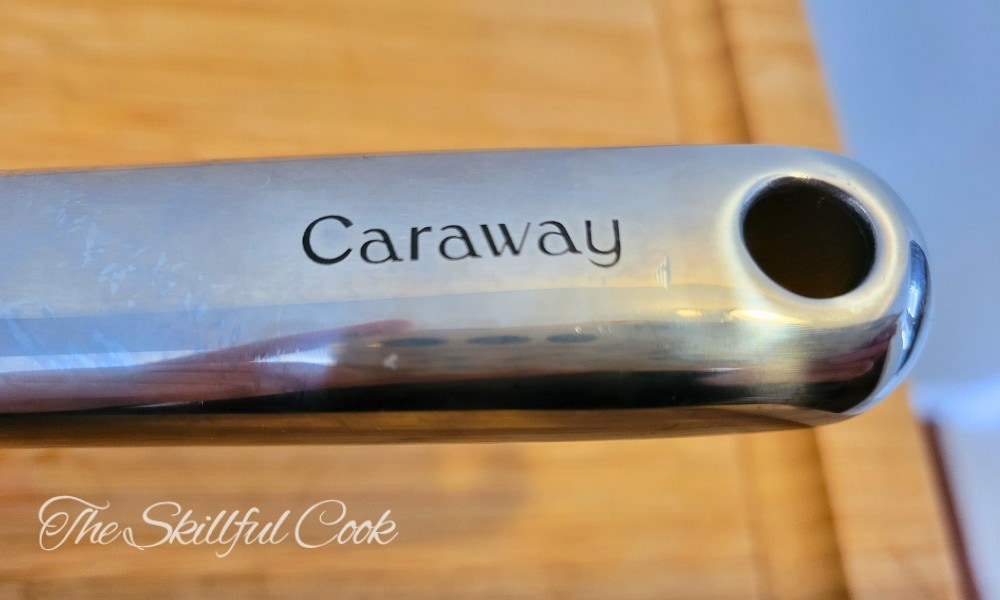
What is Caraway Cookware?
Caraway is a luxury brand of ceramic-coated cookware. Its signature product is made of heavy aluminum with a light gray mineral-based nonstick coating. Caraway cookware is Teflon-free. It’s known for its bright colors and the company’s bold safety claims. Caraway is an American brand that manufactures its products in China.
For this review, I tested a 10.5” Caraway skillet in navy.
Comparison Table vs Other Brands
Caraway
Size:
10.5” Fry Pan
Cooking Surface Diameter:
8”
Weight:
2.5 pounds
Oven-Safe?
up to 550°F (288°C)
Dishwasher?
Not recommended
Core Material:
4mm aluminum
Coating:
Ceramic
Country of Origin:
🇨🇳 China
GreenPan Paris Pro
Size:
10” Fry Pan
Cooking Surface Diameter:
8”
Weight:
2.2 pounds
Oven-Safe?
up to 600°F (315°C)
Dishwasher?
Not recommended
Core Material:
Hard anodized aluminum
Coating:
Thermolon ceramic
Country of Origin:
🇨🇳 China
CAROTE
Size:
10” Fry Pan
Cooking Surface Diameter:
8.27”
Weight:
1.81 pounds
Oven-Safe?
up to 480°F (249°C)
Dishwasher?
Not recommended
Core Material:
Cast aluminum
Coating:
ILAG “granite” ceramic
Country of Origin:
🇨🇳 China / 🇻🇳 Vietnam
Cooking Performance
Caraway is heavier-built than most nonstick pans. The 10” skillet weighs 2 pounds, 8 ounces. The walls are made of 4mm thick aluminum, and there’s a stainless steel induction plate attached to the bottom of the pan. This makes it slightly more tolerant of high temperatures than a typical aluminum pan.
The shape of the pan is also unique. The sides are 2.5 inches high, sweeping in a deep curve to a broad cooking surface. This shape increases the total capacity of a pan over a typical 10” skillet. By filling the pan with water, I found this pan to have a 2.5 quart capacity. There aren’t many fry pans that you could boil pasta or make soup in if you had to, but this is one of them.
The Water Test
Not only could the Caraway pan hold a lot of water, it could boil it quickly. My standard test is to fill a pan with 2 cups of water, set the power to 6 on my gas stove, and check the time to boil. The water came to a full boil at 3 minutes, 48 seconds. This is significantly faster than most pans on my stove; it appears that the heavy aluminum both heats up quickly and holds the heat relatively well.
The water bubbles were extremely even across the pan. This means that the pan doesn’t have major hotspots. I confirmed this with an infrared thermometer. Initially, there was almost no difference in temperature along the edges of the pan vs the center. As I let the pan boil longer, I started to get thermometer readings that were up to 20 degrees apart on different parts of the pan.
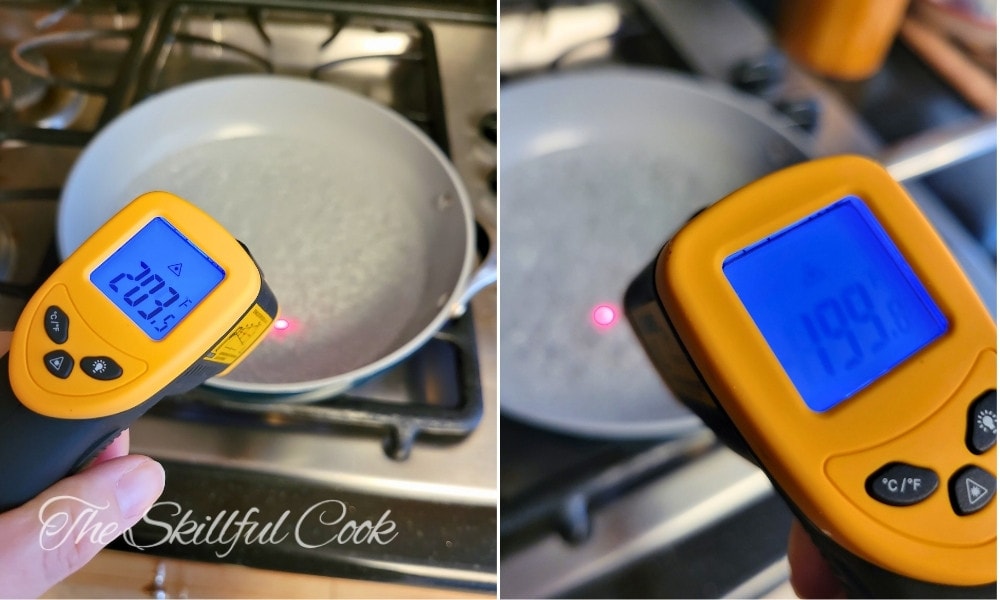
Takeaway: Caraway cookware heats quickly and evenly.
The Egg Test
The pan I tested was over a year old. Since ceramic cookware typically lasts only 1-3 years, I didn’t expect this pan to be able to cook an egg without oil. That’s something that only brand-new ceramic pans can do successfully – and then only sometimes.
But since Caraway claims to be nonstick, I tried it.
And yes, the egg totally stuck.
To my surprise, though, the egg washed off very easily. With this encouragement, I tried a second egg with just a light coating of oil – like the Caraway website suggests you can do.
That egg stuck.
Again, it was easy to wash off. But it wasn’t until I applied just as much oil as I’d use in my stainless steel pan that the egg slid around the pan.
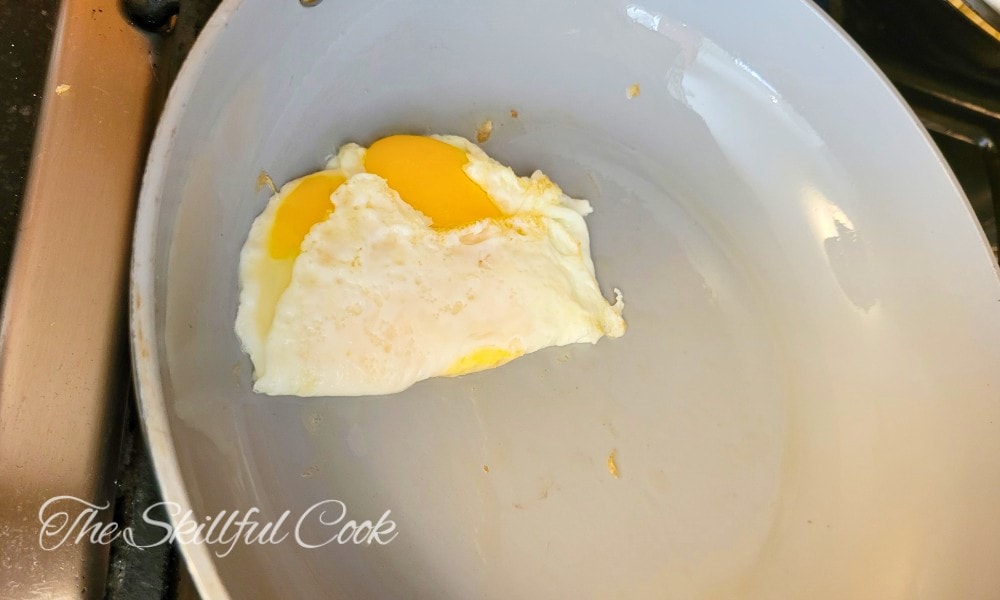
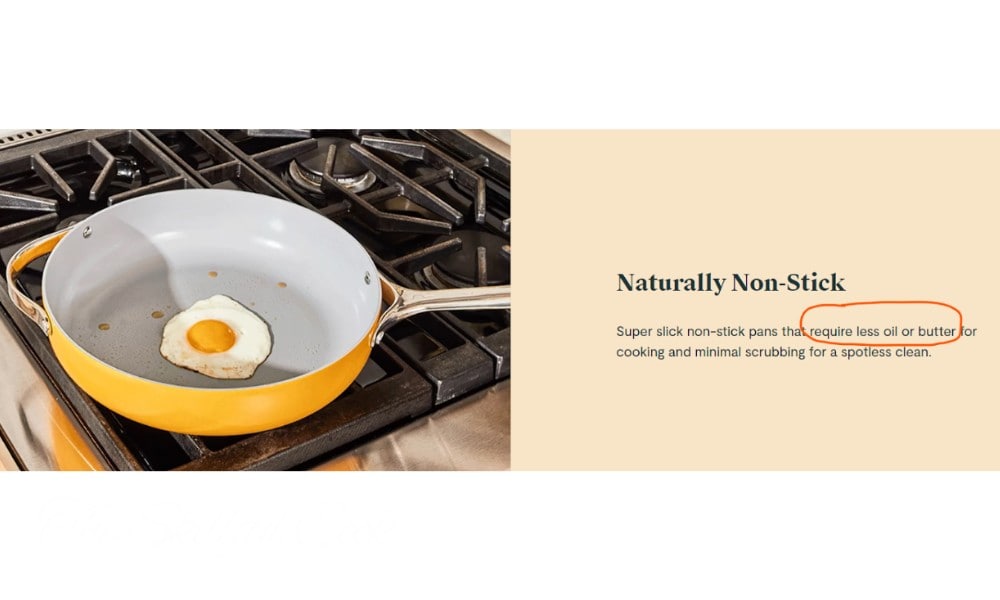
Takeaway: Don’t expect ceramic pans, even gently handled premium ones, to be super nonstick after a year.
Pancakes
Cooking pancakes gives me a sense of a pan’s heat transfer, responsiveness, and nonstick abilities. It released pancakes easily, without much oil. So even if this pan had outlived its usefulness for fried eggs, it was still plenty nonstick for some applications.
Takeaway: It took more time and higher heat to get the right color on the pancakes than in a typical aluminum pan. This is because the Caraway pan is so much thicker and heavier than competitors.
Browning Meat
I don’t typically try browning meat in a nonstick pan. Nonstick surfaces just aren’t meant for that – and they can’t be used on high heat. But given the way the Caraway pan had handled so far, I wanted to try it.
I placed two chicken thighs, skin side down, on the hot Caraway pan over medium on my stove. They browned nicely, and didn’t stick at all when I flipped them!
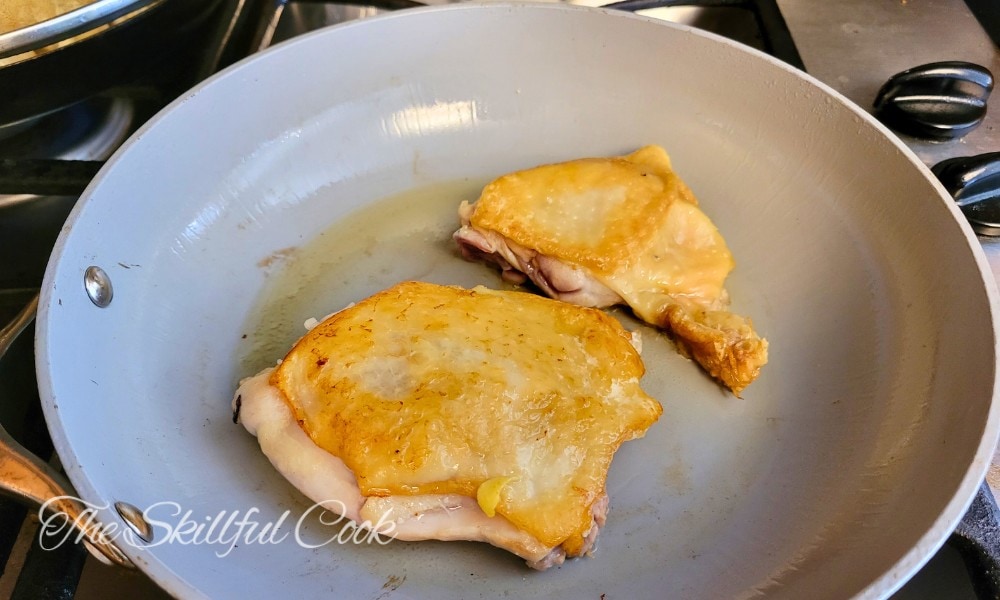
Takeaway: The more I worked with the Caraway pan, the more it felt like a truly versatile piece of cookware that could do everything from boil water to cook meat and one-pot meals. It didn’t feel like a delicate nonstick aluminum pan.
Build Quality
Caraway pans have excellent build quality. Their thick construction allows no chance of warping. The handle is attached in a wide V-shape with two rivets. Unfortunately, the high-quality construction of this pan is likely to far outlast the nonstick coating.
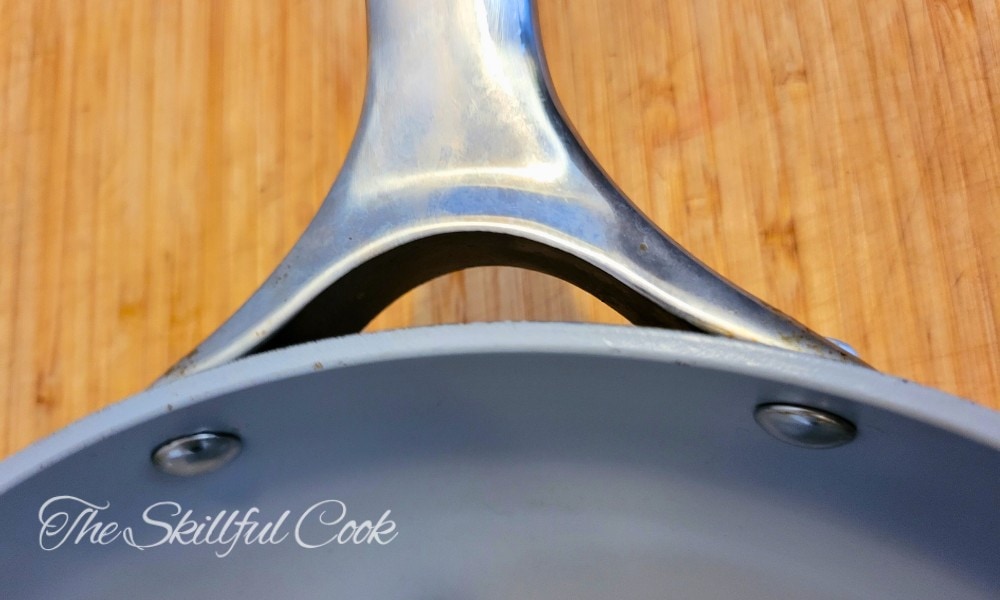
Design and Comfort
Looking at my scores so far, you’ll think I have nothing but love for this pan. That’s not true – and we’ll get to the downsides of it. But if Caraway excels anywhere, it's in its design.
The sunny colors of Caraway cookware would make any homemaker happy. Departing from standard black, gray, and cherry colors, Caraway offers pans in fun shades like marigold, cream, sage, and the rosy “peracotta.”
The sol-gel coating on the interior of the pan is light gray with a gentle sparkle. The lids have unique handles, rather than knobs.
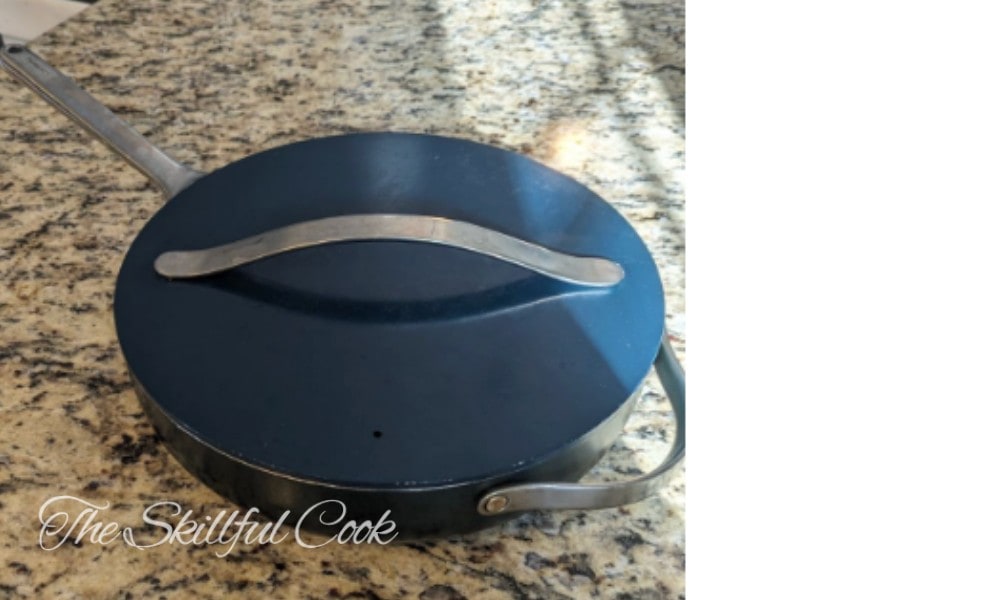
Handle Design
The handles of Caraway pans are straight and tube-shaped. They are set at a slight upward angle from the pan body. The hollow design is supposed to limit heat transfer. The handles have a bump on the underside that’s designed as a reminder that, past that point, the handle may be hot.
Does it work? Kind of. When I had my gas stove on medium, the handles got hot even beyond the “bump.” But on induction or electric stoves, this probably wouldn’t be an issue.
Versatility
The deep design of the Caraway skillet makes it able to handle all kinds of dishes, from pancakes to chili to fried rice. The saute pan is even deeper.
Caraway’s sol-gel ceramic coating can handle acidic foods, sugary foods, boiling water, and proteins. It can’t handle high heat without damage, so it’s not a good pan for searing a steak. Metal utensils will scratch it in a heartbeat, so stick to silicone with these pans.
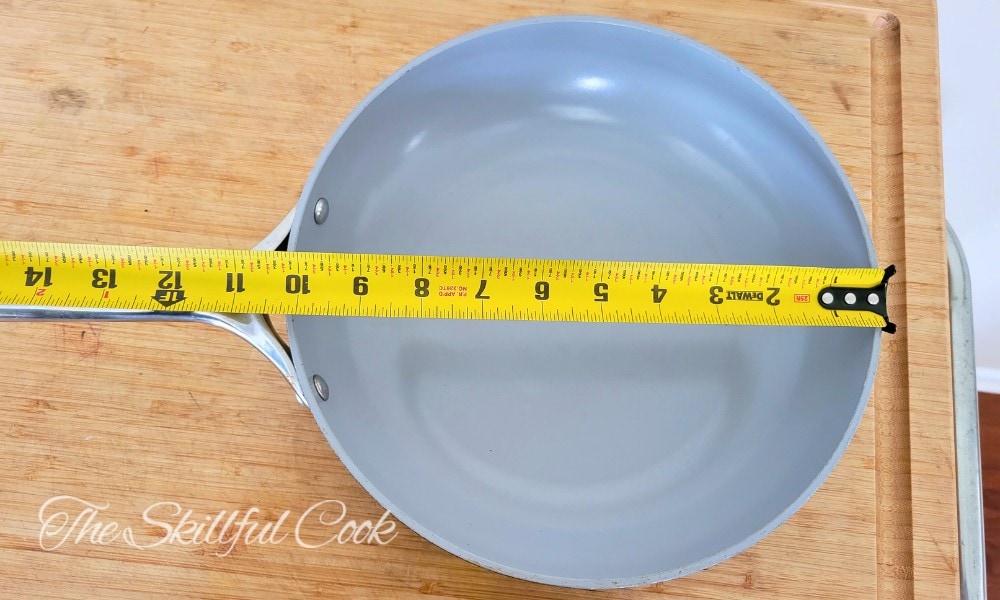
Unlike many aluminum pans, Caraway will work on induction cooktops. But I found several reports on Reddit saying that these pans don’t heat very well on induction. If you have a magnetic cooktop, then a thinner fry pan may be a better choice.
Caraway is safe for gas, electric coil, and glass stoves – but don’t use it on the grill!
Ease of Use and Maintenance
Caraway cookware is easy to maintain. It doesn’t need seasoning. It surprised me how easy it was to wash, even when eggs stuck to it. Stuck food came out easily with a paper towel, mild soap, and warm water. Don’t put these pans in the dishwasher if you want to preserve the coating.
The exterior of the pan collects polymerized oil, leading to dark brown stains. These could be cleaned with Bar Keeper’s Friend, but it will take more work. This is a huge turn-off for some users who are attracted to Caraway’s bright colors.
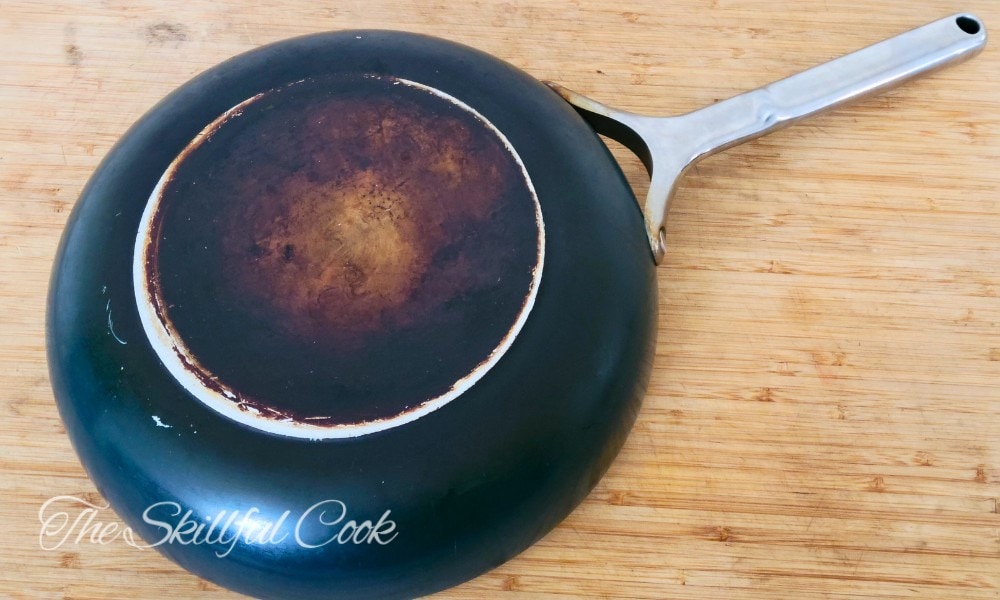
The most difficult part of using this pan was finding the right heat level to cook with. High heat will damage the coating, but the pan body is so robust that you’re tempted to crank it up.
Longevity and Warranty
Caraway cookware has better-than-average longevity for a ceramic-coated pan. The pan I tested was over a year old and only had one significant scratch on the interior. The exterior paint had stains and a little chipping. But it worked well enough that I would continue to use it.
The friend I borrowed the pan from also has a 3-year-old Caraway saute pan. As you can see in the photo below, this one has more staining and scratching.
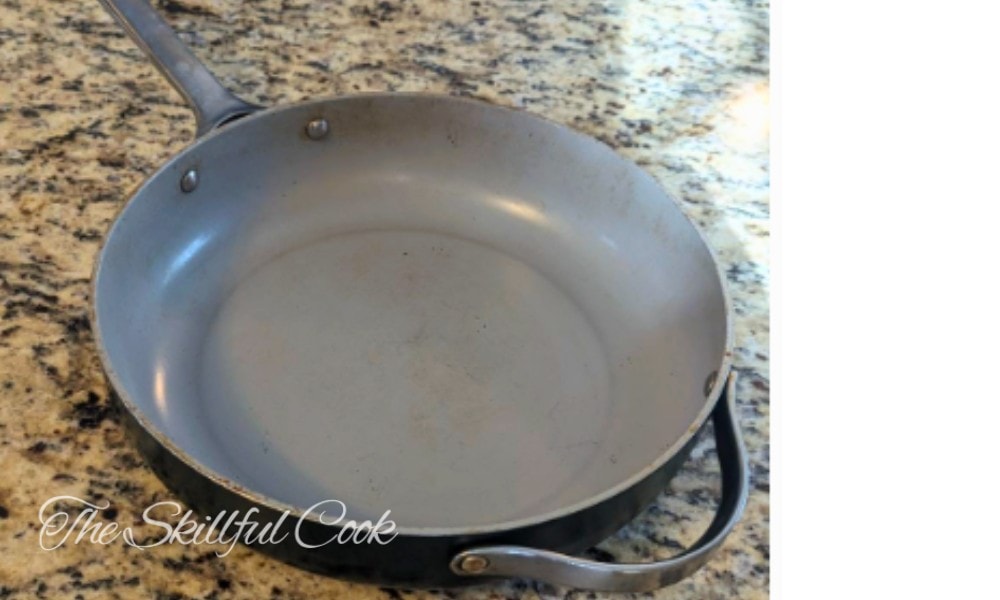
You can find online reviews from users who found their Carway pans to fail in a few weeks. You can also find reviews that say they last a year or longer. The longevity depends on your cooking style and how gently you handle these pans.
Unfortunately, Caraway has a terrible warranty. Competitors like Blue Diamond warranty their ceramic coatings for two years. The Caraway warranty only lasts a year. Take note that the company accepts returns within 30 days of purchase “if for any reason you are not happy with your order.” So be sure to test your Caraway pan thoroughly before the 30 days are up!
Price and Availability
Caraway is easy to order online if you live in the US. You can get it from Amazon and retailers like Macy’s or Williams Sonoma. It’s harder to find locally, but some Target stores carry it.
There’s one huge drawback to Caraway cookware: It’s expensive. A Caraway fry pan costs 2-3 times more than other sol-gel ceramic fry pans and is comparable to high-end Teflon pans in price. If you invest in these pans, treat them gently to make sure you get your money’s worth!
Health and Safety Considerations
Caraway’s slogan is “cookware without the chemicals.” The company invests heavily in marketing its product as free from “bad scary things” like PTFE (Teflon), PFAS, lead, cadmium, and hard anodization. Caraway doesn’t tell us exactly what is in their nonstick coating, but we know it’s a sol-gel ceramic made of some combination of minerals like silica, solvents like water or alcohol, and activators.
How do we unpack this? I’m tempted to write a whole article on the safety of Caraway cookware compared to the company’s claims. But for now, here are some bullet points:
Company and Environmental Impact
Caraway makes a big deal of its commitment to sustainability, claiming that it uses recycled paper in its packaging and that its mineral-based coating releases 60% less CO2 into the environment” (60% less than Teflon coatings, I assume?)
But the people behind Caraway don’t provide any statistics to back up their sustainability claims. And since they only offer a 1-year warranty, they clearly don’t believe their products are going to stay out of a landfill for long. Compared to cookware materials like carbon steel, stainless steel, or cast iron that truly last a lifetime, Caraway pans are not eco-friendly at all.
Caraway Cookware and Greenwashing
Caraway has been accused of greenwashing on a number of occasions, and it toes the line between clever copywriting and false advertising. (For example, claiming that their cookware is made “without chemicals” – although everything is made of chemicals! Or implying that hard anodization is in the same “harmful” category as PFOA.)
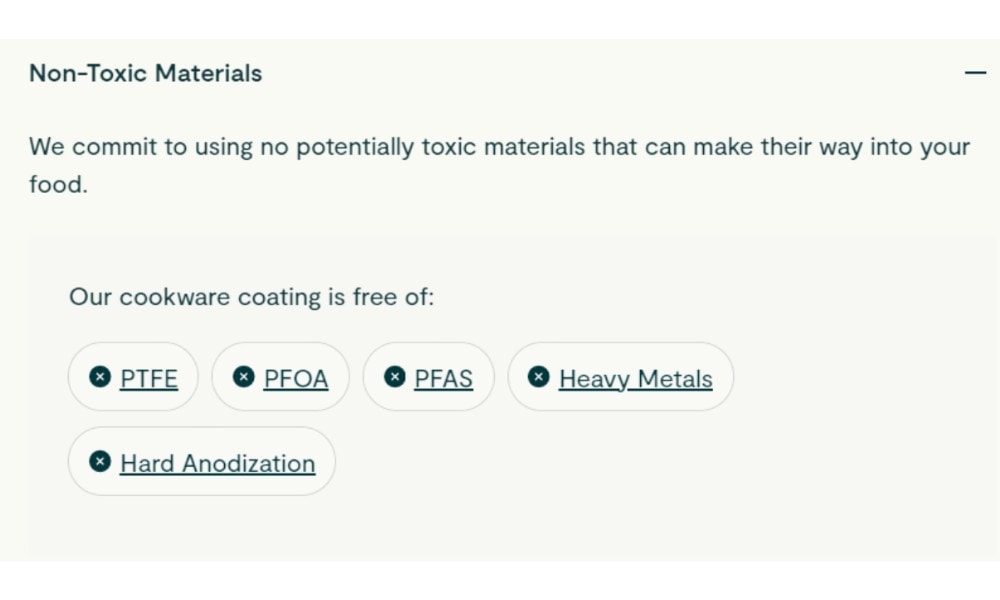
I picked out at least one conflicting claim on their website: In the screenshot below, the company claims its products are “nickel-free,” but the AB1200 disclosure says otherwise.
Of course, this is not uncommon with ceramic nonstick cookware brands. The popular GreenPan/Greenlife can be accused of similar greenwashing.
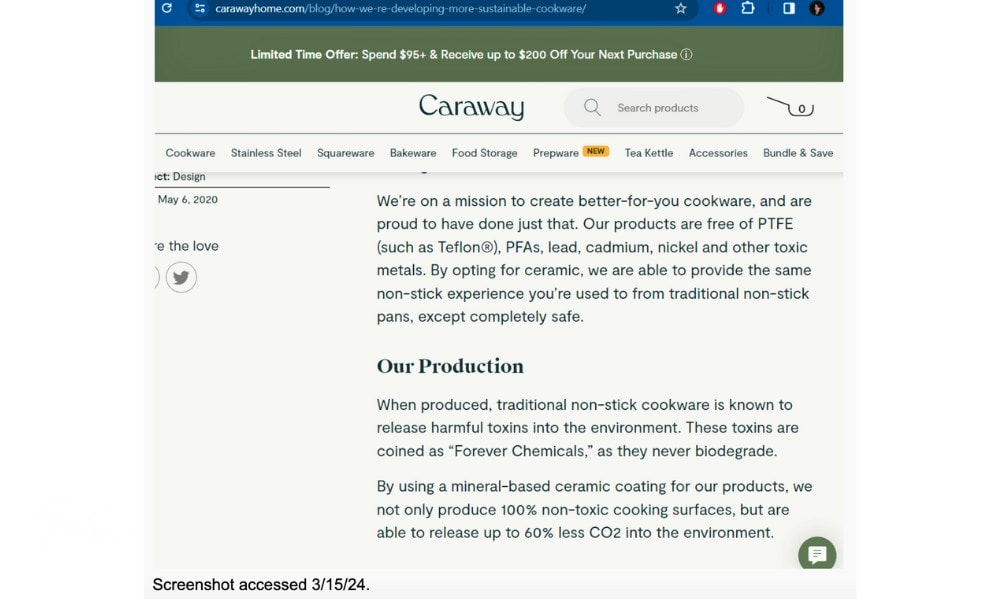
There appear to be two current lawsuits against Caraway, but they are for tax and patent issues, not product safety.
What Else Do People Say About It?
Reviews on Caraway cookware across the web are very mixed. Most people love it at first, but it falls out of favor as the bright exterior paint chips and collects stains. It seems to lose its nonstick qualities very quickly if used on high heat, but preserve them for at least a year if used as directed. The saucepans seem to last longer than the fry pans, probably because they are used more gently.
Caraway currently has a 4.1-star rating on Amazon with 2000+ reviews.
Alternatives to Consider
If you’re sold on nonstick ceramic cookware but don’t want to pay a premium price, consider GreenPan Paris Pro or Carote. The Paris Pro is the high-end GreenPan line and is most likely to have a similar lifespan to Caraway. Carote pans are much lighter weight than Caraway and have easy-to-use removable handles.
If you want something that’s going to last much longer than Caraway, consider trying stainless steel or cast iron. It’s trickier to learn to use than nonstick cookware, but it’s worth the effort.
FAQs
Is Caraway a Good Brand?
Caraway cookware is a premium brand of ceramic nonstick cookware. It’s very well-constructed and beautiful to look at. The company publishes test results to back up its safety claims. But it only offers a one-year warranty, and the coating isn’t likely to last much longer than that.
Is Caraway Really Non-Toxic?
According to third-party lab results, Caraway is free of leachable heavy metals like lead, cadmium, and mercury. Like all other ceramic nonstick cookware, it is made without synthetic fluoropolymers like Teflon (PTFE). Caraway stainless steel cookware contains nickel and chromium, but these metals are not found on the cooking surface of its ceramic cookware.
Where is Caraway Cookware Made?
Caraway is an American-owned brand with US offices in New York, but its products are manufactured in China. According to the Caraway website, its manufacturing partners in China adhere to BSCI or SMETA standards. These standards address issues such as working conditions in global supply chains.
Is Caraway Cookware Worth It?
Caraway cookware is stylish, trendy, and a great buy for someone interested in non-toxic cookware and not limited by budget. Its versatile shape and sturdy build make it feel more like professional cookware than a cheap everyday pan. But have realistic expectations with your purchase: Caraway cookware will only last for 12+ months if you treat it gently.
What’s your experience with this brand? Do you have any other questions about it? Let us know in the comments! We value your thoughts.

